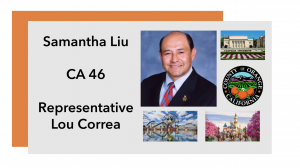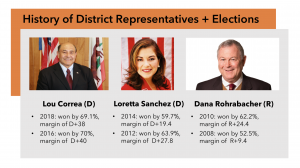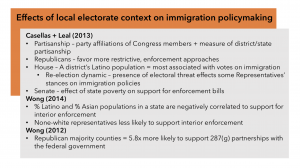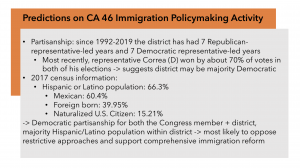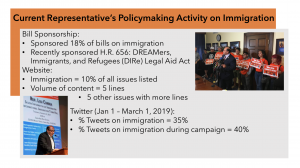Summary:
For almost 70 years, Orange County, where district CA 46 is found, has remained strictly Republican, an anomaly within the majority blue state of California. However, CA 46, represented by Democrat Lou Correa, has itself stood as a deviation from this predominantly red county; for the past seven years, this district has been claimed by Democrats. Within the district, demographic shifts have led to a staggering increase in the Latino population, as the foreign-born population also continues to grow while the white population has decreased significantly. Scholarly research reveals how this demographic change has led to increased support for pro-immigration policies. Correa has proved himself to be an outspoken leader of immigration reform at the national level. However, white backlash among Republicans in Orange County prompts me to recommend that Correa adopt a more active stance on immigration at the local level, while maintaining his current actions on immigration related issues at the national level.
Op-ed:
For almost 70 years, Orange County, where district CA 46 is found, has remained strictly Republican, an anomaly within the majority blue state of California. However, CA 46, represented by Democrat Lou Correa, has itself stood as a deviation from this predominantly red county; for the past seven years, this district has been claimed by Democrats. However, this was finally no longer the case when the November 2018 midterm elections “toppled what had long been a fortress of conservative Republicanism” as Democrats captured four Republican held congressional seats to turn Orange County blue. This shift also reflects the county’s history of presidential voting; the 2016 presidential race was the first in which Orange County backed the Democratic candidate over the Republican in 80 years. These results reflect the changing demographics that have transformed Orange County, including CA 46.
Between 2007 and 2017, the total population of the congressional district rose by 78,792. The percentage of whites significantly decreased by -41 percentage points (pp) during this time, while the Hispanic/Latino population dramatically grew by +48.3 pp. Among other racial demographics, Blacks increased slightly by +0.6 pp, while Asians decreased by -5.5 pp and Other races increased by +26.2 pp. Within the immigrant population size, specifically looking at Hispanic/Latino immigrants, the foreign-born population overall increased by a substantial +43.1 pp. Within this population, both foreign-born naturalized citizens and foreign-born non-citizens also increased, with +36.3 pp for the latter and +37.7 for the former. The significant changes among the White and Hispanic populations suggest that CA 46 is undergoing a rapid demographic shift as more Hispanic immigrants settle within the district and Whites leave, causing the congressional district to be majority Hispanic.
This drastic demographic change has a profound effect on the handlings of the issue of immigration. In research done by Casellas and Leal (2013), the two found that partisanship increasingly structures Congressional voting on the issue of immigration. The party affiliations of Congressional members as well as the measure of partisanship within districts and states had a significant effect in all House votes and most Senate votes (Casellas and Leal 2013). Republicans tended to favor more restrictive and enforcement approaches, while Democrats had an opposite approach. Within the House, Casellas and Leal (2013) found that a district’s Latino population is most associated with votes on immigration; the larger the population, the more likely a member will support comprehensive immigration reform and oppose restrictionist proposals.
These findings are consistent with CA 46 representative Lou Correa’s supportive stance on immigration. 18% of the bills he has sponsored are related to immigration, and more recently in January he sponsored H.R. 656: DREAMers, Immigrants, and Refugees (DIRe) Legal Aid Act which “require[s] the Attorney General to make grants to nonprofit organizations to offer legal assistance to certain aliens lawfully admitted for permanent residence, DACA recipients, and refugees, and for other purposes.” Furthermore, earlier this year following the January government shutdown, Correa was one of 19 Democrats who voted “no” on the fiscal 2019 appropriations package which was proposed in order to avert another shutdown. He and 13 other Hispanic Caucus members opposed any additional funding towards the border wall and were also against the bill’s immigration enforcement provisions. Clearly, Correa is staunchly in support of immigration on the national level. However, this is not to say that he is as active on the local level.
Given the significant increase in Latino population within CA 46, immigrant integration and representation both seem to be positive in the district. My media content analysis study comparing the tone and focus of articles in the Orange County Register, an English news source, and the Excelsior, a Spanish news source, found that the tone of the English news source was majority neutral, while that of the Excelsior was majority positive. These results are justified by the increase in bilingual and Spanish-speaking residents within CA 46, and support Abrajano and Singh’s study which found that Spanish language news covers immigration in a more positive and informative perspective than English language news (Abrajano and Singh 2009). Furthermore, Latinos who use both English and Spanish news sources are more likely to hold positive views towards immigration than Latinos who rely only on English news sources (Abrajano and Singh 2009). This non-hostile rhetoric among local media coverage of immigration suggests that immigrant integration and representation are positive within the district.
Despite the pro-immigrant sentiment of CA 46, Orange County’s Republicans still wield substantial vocalization and political power. In March of 2018, the Orange County Board of Supervisors voted to join the Trump lawsuit against California’s state sanctuary laws, proposed in Senate Bill 54. With a Hispanic population now larger than ever, this political action seems to fully complicate Casellas and Leal’s findings. However, research from Abrajano and Hajnal (2015) offers an explanation to the situation. They found that the larger the number of Latinos in a state, the more likely white Americans are to identify as Republican (Abrajano and Hajnal 2015). Not only does California have more immigrants than any other state, but based on Abrajano and Hajnal, it can be argued that the rising Latino population of Orange County sparked a white backlash among the county’s Republicans.
Given this, it would be wise for Correa to be more vocal of his support of immigration at the local level, while maintaining his current level of involvement on immigration related issues at the national level. Doing so will allow him to counter the anti-immigrant sentiment advocated by Orange County’s Republicans. Taking a more active stance on promoting immigration at the local level can involve publicly supporting local immigrant advocacy groups and working with Hispanic City Council members, such as Santa Ana mayor Miguel Pulido, to preserve California’s state sanctuary laws. Given the shifting demographics and growing Latino population within Orange County in general, Correa’s active involvement on issues of immigration at the local level would most likely be met with support and encouragement.
